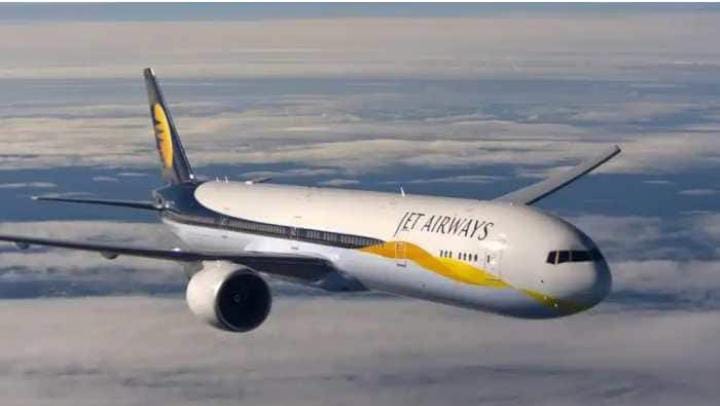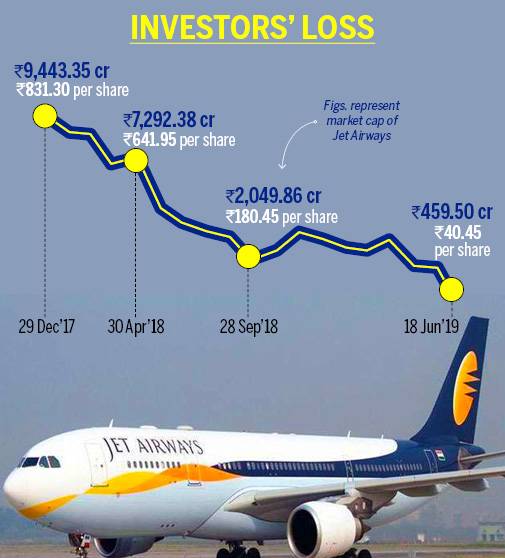JET AIRWAYS CASE STUDY
After India opened the skies to private airlines in 1992, Naresh Goyal created Jet Airways. Jet Airways (India) Private Limited, one of India's best and largest private airline companies, which dominated the Indian skies until 2005, has been grounded and operations have ceased.
After India opened the skies to private airlines in 1992, Naresh Goyal created Jet Airways. Jet Airways (India) Private Limited, one of India's best and largest private airline companies, which dominated the Indian skies until 2005, has been grounded and operations have ceased. The airline's final flight was on April 17, 2019, from Amritsar to Mumbai, and it hasn't been operating since. Over 20,000 people have been adversely impacted by the company's closure, which has a billion-dollar debt. This case study examines the factors that contributed to the demise of one of India's best airlines.

The airline started operating as an air taxi operator in 1993 after being incorporated as a limited liability company in April 1992. International flights were added in 2004 after it started full-fledged operations in 1995. In 2005 and 2007, when it bought Air Sahara, the airline went public. In the years that followed, it was compelled to decrease ticket prices to keep up with its rivals, primarily SpiceJet and IndiGo, which hampered overall performance and led to significant financial losses. With a 17.8% passenger market share in October 2017, it fell to the second position behind IndiGo. In 2019, the bankruptcy occurred as a result of the ongoing decreasing trend. It was the only other full-service airline in India before the establishment of Vistara, aside from Air India. It stopped functioning in April 2019. Early in 2022 is when operations are expected to resume. It conducted a test flight on May 5, 2022, the 29th anniversary of its formation, which is a requirement for acquiring an air operator’s permit (AOP).
It was a reputed private airline in India and it flew to 63 destinations in India and abroad. It connected various international cities including New York, Toronto, and London et operated a fleet of 97 aircraft which includes Airbus and Boeing. Jet Airways was listed on the Bombay Stock Exchange in 2004 and offered IPO. It grabbed a giant market share in the Indian domestic market and ruled the skies till 2005.
Major Reasons for the downfall of Jet Airways
By market value, Jet Airways was the largest airline in the country, but it is now insolvent. It took place because there was fierce competition amongst the competing airlines. Due to their business practices, SpiceJet Ltd. and IndiGo have largely displaced Jet Airways from the market as the low-cost airline idea gains popularity with passengers.
1. Being a Full-Service Airline:
Full-service airline Jet Airways provided travel in first, business, and economy classes on the same aircraft. Running a full-service airline in India is quite difficult since doing so needs a lot of strategies and power to separate the many segments of Indian society. Additionally, it needs a lot of financial help. In comparison to Jet Airways, a Full-Service Carrier, Air Deccan, Indigo Airline, Spice Jet, and GoAir launched low-cost carriers in late 2003 and offered tickets at lower prices. Low-cost carriers didn't provide any unique services, so they offered affordable tickets, increasing their market share and hurting Jet Airways. Jet Airways in 2005 at an initial public offering (IPO) price of INR 1,100 per share and a market capitalization of 11,200 cr. After this, the stock market never again reached the 1100 point.

2. Wrong Acquisition:
Jet Airways acquired the failing Air Sahara in 2007 for a staggering Rs 1,450 crore, an investment that was crucial for the airline because it was far more than the airline's true value. As seen by the merger of Kingfisher Airlines and Air Deccan as well as Air India and Indian Airlines, mergers in the Indian aviation industry have historically resulted in business failure for the firms involved. Sahara Airways was purchased by Jet Airways and given the brand Jet Lite to compete with low-cost carriers. Jet Airways suffered a huge setback as a result of the rebranding since Sahara was a dominant brand and the customers it attracted could not connect with Jet Lite. Jet acquired Air Sahara and raised its pricing. Despite providing comprehensive services, they had to lower their pricing because of competition. The company's financial situation was severely impacted by this, and the profit began to decline.
3. Bankruptcy:
Bank debt for Jet Airways is 8,500 crore. Additionally, the airline owes 10,000cr to suppliers, aircraft lessors, and overworked staff who have not been paid. The company owes 36,500 Cr in debt, and because it is a service business, it has very few assets to collect.
4. Leadership Issues:
Naresh Goyal, the founder of Jet Airways, was a despotic ruler or a one-man army. He had terrible financial judgment and hired a weak management committee. A single management team was responsible for overseeing all Jet-related operations. Jet Airways' demise is the result of poor management. The crisis was mostly brought on by a lack of leadership, poor communication, micromanagement of resources, lack of vision, etc. at Jet Airways.
5. Resuming Jet Airways:
After its creditors accepted a proposal from businessman Murari Lal Jalan and asset management company Kalrock, which is a part of the Fritsch Group, an investment company founded by serial real estate and tech entrepreneur Florian Fritsch, India's Jet Airways will resume flights in the first quarter of F.Y. 2022–23. According to an oral directive, Jet Airways-II might launch as a full-service domestic airline with a fleet of six aircraft next summer. On Thursday, May 6, 2022, Jet Airways resumed flight after a three-year hiatus. To verify the safety of the aircraft, this flight served as testing. On May 20, 2022, it was granted an air operator's certificate.
All these factors combined, led to the downfall of one of the biggest airlines in the country. It went bankrupt at a time when the nation desperately needed to develop the aviation industry and the aviation infrastructure and became one of the biggest examples of the saying
– “Long-term poor management is a formula for disaster.”
